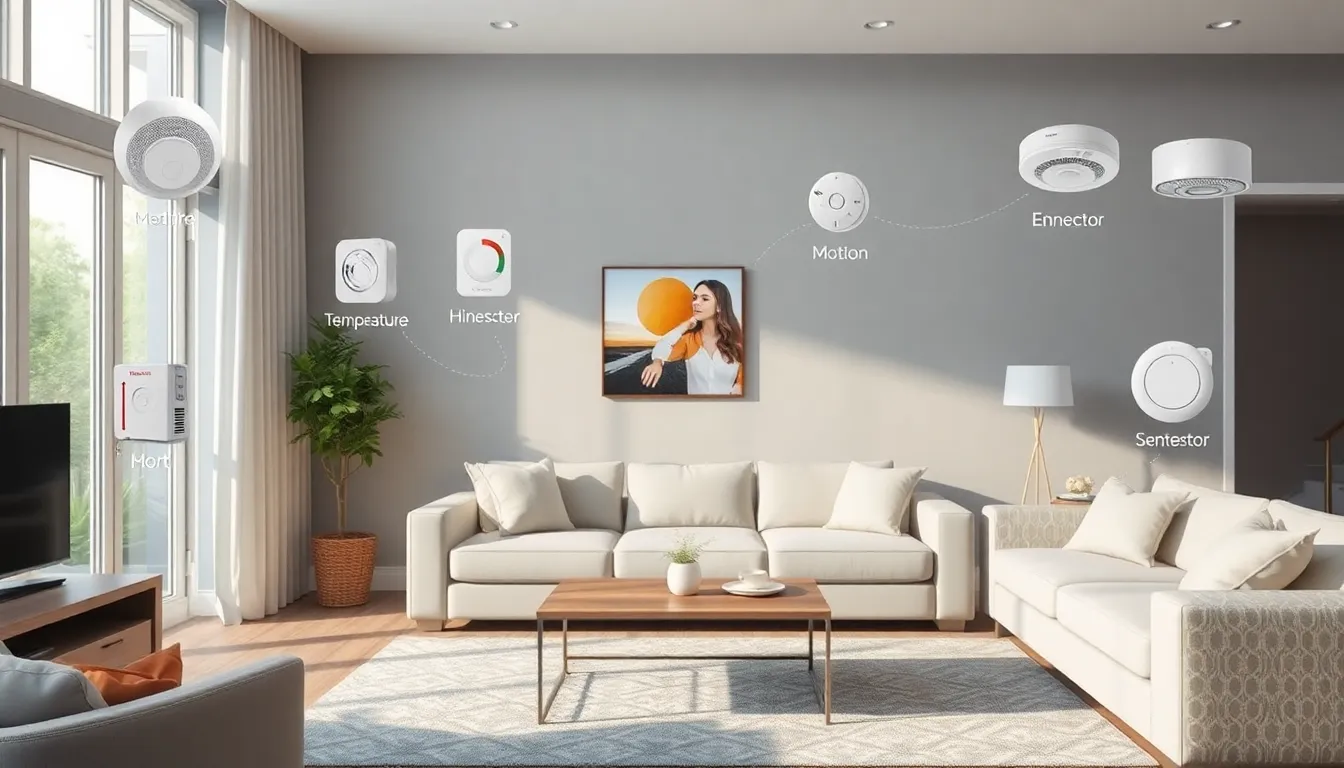In today’s world, home sensors are like the Swiss Army knives of smart living. They’re not just gadgets; they’re your home’s personal assistants, quietly working behind the scenes to keep everything in check. From detecting leaks faster than a cat spotting a cucumber to ensuring your front door is as secure as Fort Knox, these little wonders are transforming homes into havens of convenience and safety.
Table of Contents
ToggleOverview of Home Sensors
Home sensors play a crucial role in enhancing the functionality of modern smart homes. These devices monitor various aspects of the household environment, providing real-time data and alerts. Temperature sensors, for instance, help maintain an optimal climate by detecting temperature fluctuations. Motion sensors enhance security by identifying unexpected movements within the home.
Utilizing moisture sensors prevents costly damage through early leak detection. By alerting homeowners to potential flooding or pipe bursts, they protect property and give peace of mind. Smoke detectors, another vital type, automatically notify occupants of fire hazards, facilitating a prompt response.
Smart home integration amplifies the benefits of these sensors. They can communicate with other devices like smart thermostats and security systems, creating a cohesive network. For example, when a smoke detector signals an alert, it can trigger an automatic response to unlock doors and turn on exterior lights.
Energy management is another advantage offered by home sensors. Light sensors adjust indoor lighting based on daylight availability, promoting energy efficiency. When room occupancy is detected, smart lighting systems can turn on or off, conserving electricity.
Data analytics from home sensors provide valuable insights into household patterns. Homeowners can track energy usage trends and make informed decisions to improve efficiency. With advancements in technology, future sensors are set to become even more sophisticated, integrating artificial intelligence to enhance their capabilities.
Operating seamlessly within smart homes, home sensors contribute significantly to convenience, safety, and efficiency. The combination of various sensor types creates a more responsive living environment, ensuring the needs of inhabitants are met swiftly and effectively.
Types of Home Sensors

Home sensors come in various types, each designed to tackle specific needs within smart living environments. Their unique functionalities contribute to overall safety, efficiency, and convenience.
Motion Sensors
Motion sensors detect movement within designated areas, enhancing security levels. They activate alarms when unexpected motion occurs, serving as effective deterrents against intruders. Occupants receive instant alerts through connected devices, integrating seamlessly with security systems. In addition, these sensors support home automation by turning lights on or off as people enter or exit spaces. Cost-effective solutions exist for both indoor and outdoor applications, offering flexibility in design and placement.
Temperature Sensors
Temperature sensors maintain ideal climate conditions by monitoring indoor temperatures. These sensors automatically adjust heating and cooling systems to optimize energy use. Alerts notify occupants of extreme temperature fluctuations, allowing for immediate action to protect belongings. Home automation systems utilize data from temperature sensors to improve comfort and reduce energy waste. Various models offer compatibility with smart thermostats, promoting integrated control of a household’s climate.
Smoke and Carbon Monoxide Detectors
Smoke and carbon monoxide detectors play critical roles in home safety. They continuously monitor air quality for toxic gases and smoke, ensuring early warnings in emergencies. Alerts prompt quick actions, such as notifying homeowners or triggers for automatic responses like unlocking doors. Integration with other smart devices enhances overall safety by creating a unified alert system. Battery-operated detectors also provide flexibility in placement, while smart detectors offer connectivity features for remote monitoring and alerts.
Benefits of Home Sensors
Home sensors offer numerous advantages that enhance comfort, safety, and efficiency in modern living environments. These devices provide valuable insights and automated solutions for everyday challenges.
Enhanced Security
Enhanced security is a primary benefit of home sensors. Motion sensors provide real-time alerts if unexpected movement occurs within controlled areas. Door and window sensors also notify homeowners of potential breaches, reinforcing security measures. Smart cameras can integrate with these sensors to offer live video feeds on mobile devices. Additionally, the connection with home automation systems allows for immediate responses, such as sounding alarms or notifying authorities when unusual activity is detected. Such proactive measures significantly reduce the risk of theft or intrusion.
Energy Efficiency
Energy efficiency serves as another critical benefit of home sensors. Temperature sensors adjust heating and cooling based on occupancy, promoting optimal climate control. Smart lighting sensors turn off lights in unoccupied rooms, preventing wasted energy. As occupancy patterns change, homeowners gain insights into energy usage trends. These sensors help identify peak usage times, allowing for informed decisions on energy conservation strategies. Such automation not only reduces utility bills but also contributes to a greener environment.
Peace of Mind
Peace of mind represents an essential benefit of home sensors. Smoke and carbon monoxide detectors alert residents to potential dangers, facilitating timely evacuations. Leak detection sensors help prevent significant damage and costly repairs by notifying homeowners of moisture issues early. Integration with smart home systems provides seamless responses to alerts; for example, doors can unlock automatically during an emergency. Homeowners gain reassurance knowing that these systems work around the clock to safeguard their spaces and loved ones.
Choosing the Right Home Sensors
Selecting the right home sensors involves assessing individual needs and ensuring compatibility with existing systems.
Consider Your Needs
Identifying specific requirements simplifies the selection process. Assessing safety, convenience, and energy efficiency helps homeowners focus on the most critical sensor types. For instance, someone concerned about leaks may prioritize moisture sensors, while a family focused on security might choose motion detectors and smart cameras. Understanding how each device interacts with daily life influences choice, enabling tailored solutions that enhance home functionality.
Compatibility with Smart Home Systems
Ensuring compatibility with smart home systems maximizes sensor benefits. Consumers must check if sensors integrate with existing platforms like Amazon Alexa or Google Assistant for seamless operation. Choosing sensors compatible with other devices boosts their effectiveness, allowing for automated responses and notifications. Smart home ecosystems thrive on interoperability, linking motion detectors with alarms and smart lights for enhanced security. Prioritizing compatibility ensures that future upgrades fit smoothly into the existing setup.
Home sensors are transforming the way people experience safety and convenience in their living spaces. By providing real-time monitoring and alerts they empower homeowners to respond swiftly to potential hazards. The integration of these devices into a cohesive smart home ecosystem not only enhances security but also promotes energy efficiency.
As technology continues to evolve future home sensors will likely offer even more advanced features. This means homeowners can expect greater insights and automation capabilities tailored to their specific needs. Embracing home sensors is a step toward a more secure and efficient lifestyle that prioritizes both comfort and safety.








